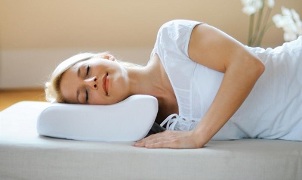
Cervical osteochondrosis is a more dangerous type of disease than chest and lumbar osteochondrosis. This fact is explained by the fact that the neck is in the immediate vicinity of the head. Therefore, when the structure of the neck is damaged, various disorders begin in the work of the brain, visual organs, hearing and speech.
Therefore, doctors recommend starting treatment as soon as the disease is diagnosed. Especially if you are in the early stages.
Treatment of cervical osteochondrosis at home may even be recommended. You should receive detailed instructions and suggestions from your doctor immediately before starting treatment.
Causes of the disease
Knowledge of the causes of cervical osteochondrosis is necessary to ensure that treatment is not in vain. After all, if the factors contributing to the development of the pathology are not eliminated, osteochondrosis may recur.
Main causes of osteochondrosis of the neck:
- Age - in the elderly, pathology often develops due to the physiological aging processes of the body. But in recent decades, the disease has become “younger” and is diagnosed in 30-year-old patients. The reason for this is the change in modern lifestyle, occupational factors, eating preferences.
- Profession or hobby - in most cases, degenerative-dystrophic changes in ODA tissues begin in people who overload the cervical spine or, conversely, do not provide a normal load. For example, professional heavyweight athletes overload their bodies by doing strength training. And people who work at a computer or are usually in a sitting position, on the contrary, are "underloaded. "In the latter case, there are no dynamic loads, but the static loads are very severe during long periods of stillness.
- Injuries, cervical hypothermia, or surgery in this area.
- Inheritance.
- Metastases in tumors of the spine or other organs.
- Poor mattress (too or not strong enough), unsuitable pillows, prolonged lying or sitting (on bed, couch).
The cause of osteochondrosis of the cervical spine can even be a poor diet. Or there may be more reasons. The factors that contribute to the development of the pathology are determined by the doctor in the process of diagnosis. And during and after treatment, it will be necessary to eliminate these factors or try to reduce their pathological effects.
Symptoms and possible complications

Cervical osteochondrosis may initially develop asymptomatically. Or the discomfort in the neck and other signs can be attributed to other illnesses, fatigue, stress, atmospheric conditions.
However, if you have more than one symptom at the same time, this should be treated immediately:
- Neck pain that eventually spreads to the head, face, shoulders, shoulder blades, arms. The pain may go away or get worse when you turn your head in a certain position.
- Neck crack, limited mobility.
- Dizziness, fainting.
- Nausea, vomiting.
- Impaired motor skills, movement coordination, trembling hands.
- Violation of the sensitivity of the face, limbs, or vice versa, the appearance of unusual feelings - goose hills, tingling.
- Problems with the functioning of the organs of vision, hearing and speech.
- High blood pressure or increased intracranial pressure from the cardiovascular system for no objective reasons.
The occurrence of these symptoms is directly related to the dystrophic processes within the cervical spine themselves. And also with narrowing of the vertebral artery and compression of nerve tissue - these structures pass through the spinal canal and are damaged by the vertebrae.
If left untreated, dangerous complications can occur sooner or later. First, the patient loses the ability to move freely - it is a disability, a permanent disability. Second, the progression of the pathology is reflected in brain function, which can result in trauma in a fall, stroke, coma, or death.
Home Management
All methods for treating cervical osteochondrosis can be broadly divided into:
- Etiotropic and pathogenetic- those that influence the cause of the disease and the mechanism of its development. These are certain types of medications, physiotherapy, exercise, gymnastics, wearing a special collar.
- Symptomatic or palliative- those that eliminate the symptoms of the disease or help reduce their severity and intensity. Their goal is to alleviate the patient’s condition, improve their quality of life during treatment, and apply them to the first set of methods. These include taking novocaine blockades, other anesthetics, ointments, massages.
However, most therapies for osteochondrosis are to one degree or another etiotropic and symptomatic. To cure osteochondrosis quickly, you should try to use all available methods. That is, the therapy should be as complete, comprehensive, and complex as possible.
Surgical methods for treating osteochondrosis are widely used today. But in the case of mild forms of the disease, their use is not justified.
Therefore, for home treatment, you should focus on these conservative methods:
- Change in lifestyle and diet.
- Receipt or external administration of drugs.
- Home treatments - gymnastics, gym therapy, massage (at the call of a masseur at home).
- Wear a special collar or kinetic tape.
- Treatment with folk remedies.
Items 1, 3, 4 can also be used during post-disease rehabilitation and as preventive measures (to prevent future relapse).
It is desirable that the treatment program be drawn up by a doctor, or at least agreed with it. Otherwise, it is possible to cause even greater damage to the health of ODA, which significantly affects the patient’s condition and the cost of treatment.
Lifestyle and diet

Treatment will make little sense without a lifestyle, normalization of physical activity, and a review of your daily menu.
What to change:
- Sleep quality- buy an orthopedic mattress, and it is advisable to buy an orthopedic pillow.
- Cervical spine loads- should be moderate. It is advisable to give up heavy sports, to replace physically difficult work with other types of activities. You can also change jobs with passive loads. If this is not possible, you should periodically stretch your neck during the work day, moving more of your head during work hours.
You also need to start eating right. After all, they are nourished with all the necessary elements to restore the muscle, nerve, cartilage, and bone tissue of the vertebrae. Accordingly, the food should be rich in proteins, vitamins and minerals (calcium, iron, vitamins C, E, A, group B).
Medications
The main groups of pharmacological drugs prescribed by doctors are:
- Non-steroidal anti-inflammatory drugs - relieve pain and stop the inflammatory process in tissues.
- Preparations designed to relieve pain syndrome (including anti-inflammatory, warming effects). These include injections, corticosteroid tablets, ointments and creams.
- Tissue regeneration devices are ODA - chondroprotectors.
- Anticonvulsants and muscle relaxants to relax neck muscle tissue.
- Vitamins and minerals, vitamin and mineral complexes.
All medications should be taken in courses except vitamins and painkillers. Occasional admission does not yield results, which affects the effectiveness of treatment.
Procedures

The ability to perform physiotherapy at home is limited. For example, you can only massage or stretch your spine if you call a professional into your home and not everyone can afford it. But self-massage and elementary physical exercises are quite real and do not require financial costs.
Self-massage can be done with your hands, as the neck is fairly easily accessible. The self-massage technique is simple - you need to perform soft caressing and creasing movements. It is useful to use a lubricant such as Vaseline. The point is that the procedure does not cause pain.
You can massage with a towel, rubbing your neck, or with a stream of warm water in the shower. Another good option is to buy a stick like a shovel handle - a round. Such a stick is placed on the back of the shoulders, grabbing the ends and guiding it up and down the neck like a rolling pin. If possible, you can buy massage equipment. Lyapko roller massager is very useful, not expensive, its effectiveness has been proven.
neck gymnastics is also very simple. You have to make the various turns and head decisions smoothly. However, as osteochondrosis worsens, exercises do not need to be performed as the pain may simply be unbearable. This can start the cramps in the muscles of the neck.
Wearing orthopedic structures is an effective treatment
There are several benefits to wearing a custom collar:
- Supporting the spine and relieving muscle tissue.
- Tissue regeneration is more efficient.
- Improves blood circulation, including the vertebral artery. In cervical osteochondrosis - this is one of the main tasks.
- Neck restraints reduce mobility and pain.
- Protects the neck area from possible further injuries and injuries.
However, the collar has its drawbacks. Wearing it is not always appropriate in the company of other people. It can also be difficult to review and perform necessary household chores or labor manipulations. But for the duration of treatment, you should try to wear a collar according to a schedule set by your doctor.
Neck wrapping as a method of treatment has several advantages:
- Aesthetically acceptable, the ribbon is free to appear "in public". Colored ribbons, if not appropriate for a particular situation, can be hidden by high-collar clothing.
- Do not restrict physical activity.
- Moisture resistant, does not need to be removed before showering.
- Improve blood flow and lymphatic drainage, relieve pain and inflammation, edema.
- Relieves muscle tissue stress.
- Massage, stimulates the metabolic processes of the muscles, their regeneration.
Kinesia tapes have only one drawback - the goods, but many patients can afford to pay 100 rubles for a 5-meter roll.
Folk remedies for osteochondrosis

For oral use:
- Aqueous infusion of laurel or cranberry leaves.
- Parsley root decoction.
- Aqueous solution of celery juice.
- Consumption of sesame seeds.
- Herbal teas - own prizes or purchased (chamomile, nettle, oregano, hops).
- Alcoholic infusion of chopped pine nuts.
For treatment with compaction and rubbing, it is useful to use pharmacy-marketed burdock, horseradish, red pepper (infusions, decoctions) and tar or clay.
Treating cervical osteochondrosis at home is quite effective in most cases. If the degenerative-dystrophic changes have already progressed vigorously, it is recommended to combine home therapy with other treatment methods. Use the services of a physiotherapist, massage therapist, chiropractor, for example.
And if the disease has only just begun to progress, medications, home procedures, and folk methods will allow for quick results. That is, healing the spine without having to turn to the services of professionals.























